Geiko, Geisha or Maiko? The differences and the culture
Japanese culture is unique in that the country has many things that other countries do not.
One example of those is the geisha, female entertainers with meticulous training and sophisticated appearance.
Many foreigners mistook them for traditional prostitutes, which is significantly inaccurate.
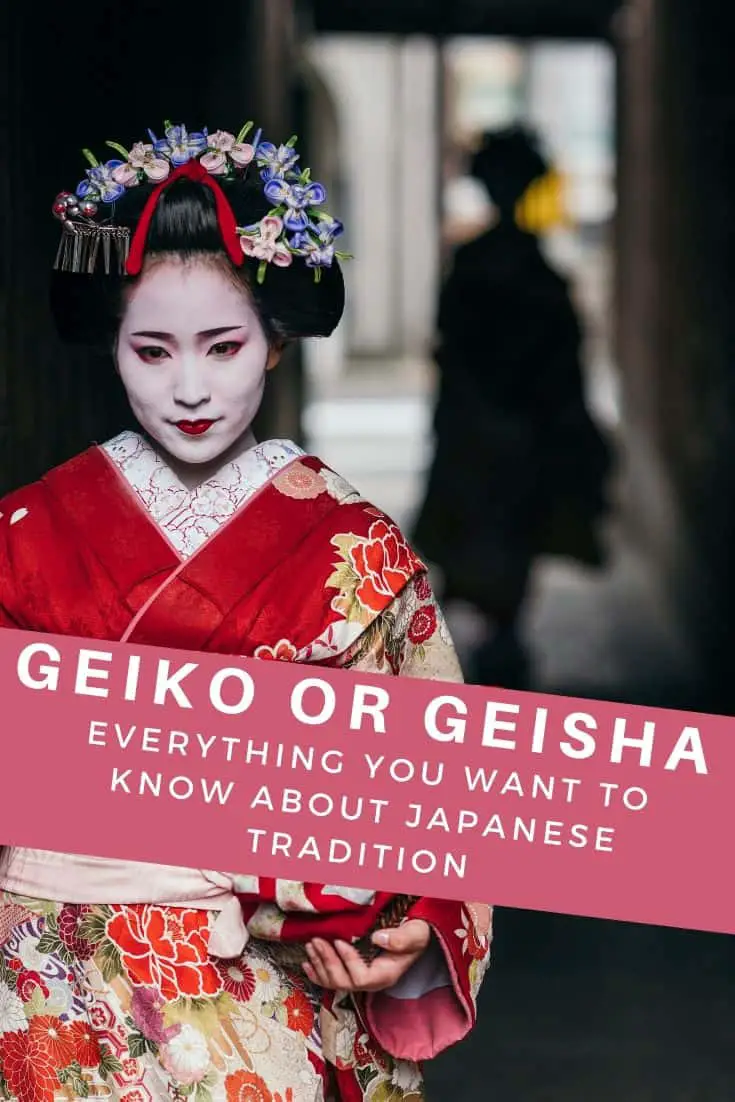
Hence, to avoid misunderstanding, let’s talk about them and everything about them:

Check out our new cookbook
Bitemybun's family recipes with complete meal planner and recipe guide.
Try it out for free with Kindle Unlimited:
Read for freeIn this post we'll cover:
- 1 What are Geiko or Geisha?
- 2 History of Geisha
- 3 How to Become A Geisha
- 4 Stages in the life of a geisha
- 5 From Maiko to Geisha
- 6 The Skills of A Geisha
- 7 How much are geisha paid?
- 8 The Okiya
- 9 The Ochaya
- 10 The Clothes and Makeup of A Geisha
- 11 Have A Geisha Kimono of Your Own
- 12 The Off-Hours
- 13 Sex, Love, and Family
- 14 How to Meet A Geisha
- 15 The Etiquette of Interacting with Geisha
What are Geiko or Geisha?
The word “Geisha” has a literal meaning of “art person” or “art doer”. Geisha is also known by the name Geiko, which means “woman of art”.
Let’s first address the issue of what exactly to call them because I know a lot of you have heard both terms before:
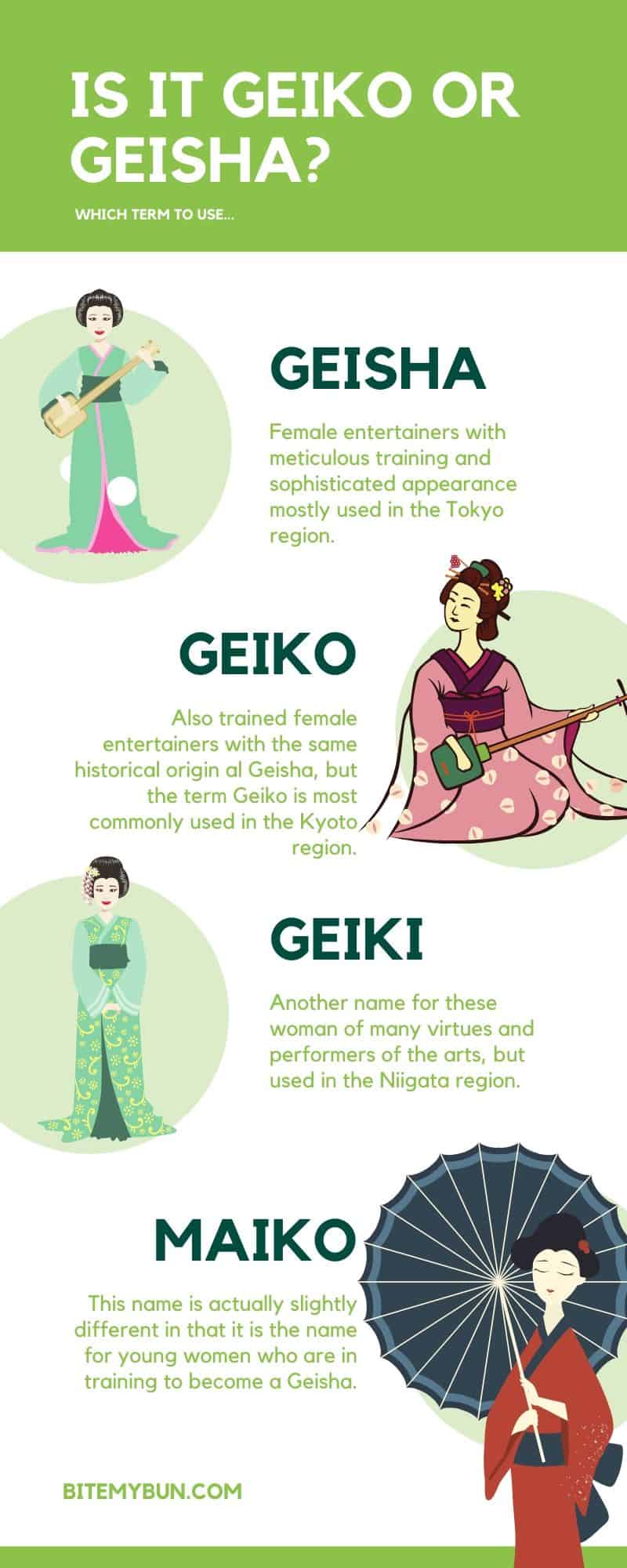
- People in Tokyo mostly use the term “Geisha”
- In Kyoto, the term Geiko is most commonly used
- Another name for these women is “Geiki”, which is most commonly used in the area of Niigata.
- You may also hear the term “Maiko”, which refers to young girls who are in training to be Geisha.
Many people outside Japan mistakenly think of Geisha as prostitutes, which is a grave mislabeling.
Geisha are not sex workers. The prostitute ones are known by a different name, “Oiran”.
They wear similar clothes and makeup like Geisha, but the jobs are entirely different.
As clear as their names, geisha are women who perform many kinds of traditional Japanese arts, like singing, dancing, and playing musical instruments.
The job of a geisha includes pouring drinks and drinking along with the guests when requested.
Sometimes they also need to indulge in an interesting conversation with the clients they escort.
History of Geisha
The geisha culture has a deep root in Japan, dating back to the Edo Period. The concept of female courtesan or entertainers was developing in that period.
These four historical cultures are what people said to be roots of Geisha:
Saburuko
Saburuko refers to the Japanese female courtesans in the 7th century. Their job included
- waiting tables
- dance
- having a conversation with the guests
- and also selling sexual acts
Many women had to take such a job due to difficult economic situations following the Taika Reforms.
Shirabyoshi
Around the 12th century, the beauty standard has changed. Talented dancers in the samurai warrior style become a popular thing.
Hence, Shirabyoshi became a highly respected career. Even highly-educated women would make poetry and ballads for the performance.
Yuujo
Around the 16th century, prostitution became a legal business. Yuujo are the “play women” who work in a place called “pleasure garden”.
The high-class Yuujo, called Tayuu, combined erotic dance (kabuki) and acting with a sense of art. Later on, they became more popular with the name Oiran.
Geisha
Female artists and dancers with high talent started calling themselves Geiko. The line gradually developed, differentiating them from Oiran, whose selling points are still sex.
Since the Geiko popularity rose pretty quickly, the brothel house got concerned that the Oiran might lose its relevance.
Hence, Geisha were from then on forbidden to sell the act of sex.
After World War II, many Japanese women dressed up like geisha and offered sexual services to American military men.
They marketed themselves as “geisha girls”, which then caused a misunderstanding about the profession.
In 1959, the government forbade any form of prostitution. The law effectively disbanded the existence of Oiran and the Pleasure Garden.
Only Geisha can still run in the business, but even they are not allowed to sell sexual services to the customers.
How to Become A Geisha
Geisha need to have advanced skills and knowledge in many kinds of traditional Japanese performing arts and culture.
Hence, training is highly necessary. And even before the training, a girl needs to have some essential traits if she wants to be a successful geisha.
These traits include high discipline, focus, dedication, and cleverness.
To be a Geisha, you need to get recruited to an Okiya (geisha house).
Can foreigners become geisha?
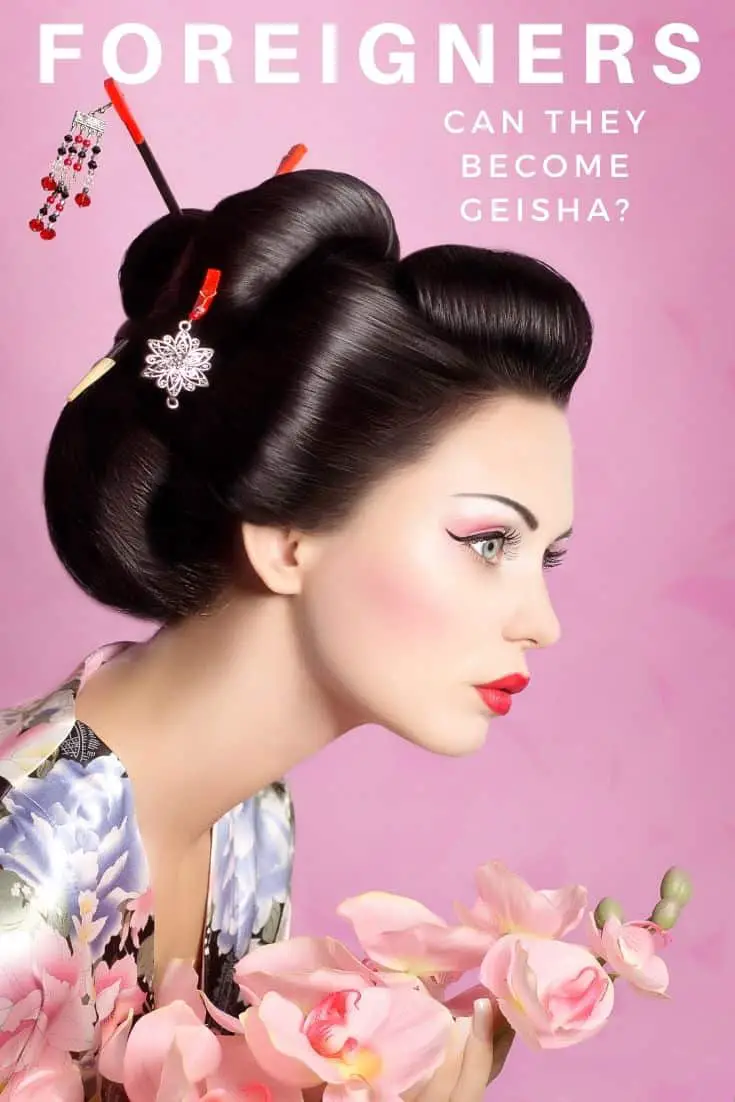
Although geisha are traditionally Japanese, foreigners can also enlist to be a geisha as long as they are fluent in Japanese and are willing to be trained.
Traditionally, girls started their training at a very early age, around five or six years old. Most of them were sold by poor families, and the rest were recruited.
They did not go to school as they had to focus on their geisha training.
However, the government has mandated that every kid should attend school, and should enroll in the training willingly.
In modern days, most people start around the age of 15-16 in Kyoto and around 18 in Tokyo. The age of 21 years old is considered too old to be a Maiko.
Hence, any girl who enrolls in an Okiya after she turns 21 would not debut as a Maiko.
She will go through intense training for a year or so to debut straight away as a Geisha.
Stages in the life of a geisha
The training of a Geisha is demanding and meticulous. People usually start at a very young age so they have enough time to perfect their skills.
However, nowadays, the training process is significantly shorter. Some people even take only a year to finish their training.
The traditional training of Geisha consists of several steps, including:
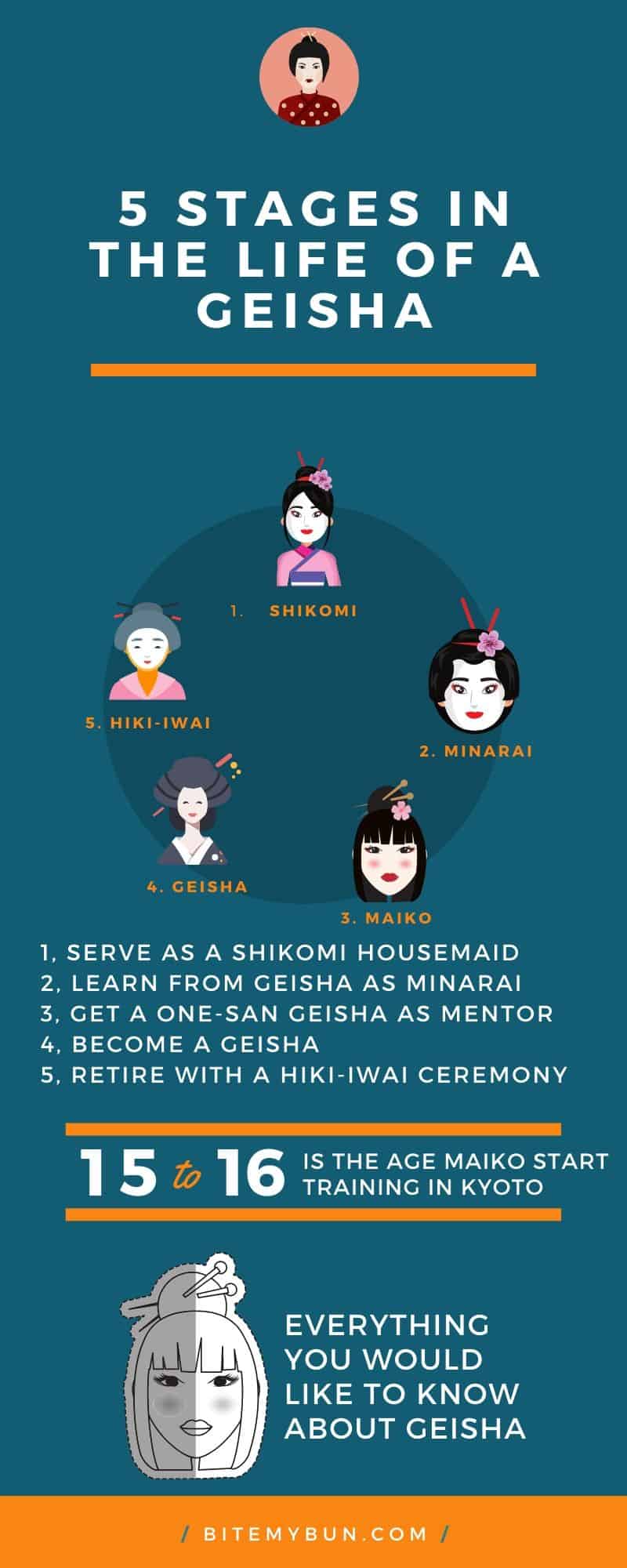
Shikomi
Before starting the training to be geisha, girls must serve as housemaids in the okiya (geisha house). The term used for this stage is shikomi.
Although it is just some house chores, their trainers will make their job hard on purpose.
The harsh training is intended to determine how tough and determined the shikomi is.
If they make it, they can move on to the next stage of the training. Yet if they fail, they may leave the okiya and forget about their dreams of becoming geisha.
Minarai
Being a Minarai means they no longer have to deal with intense house chores. They can start learning on how to be geisha by observing how the geisha do their jobs.
Minarai can’t get invited to parties yet, but they can attend as a plus-one of a senior geisha.
The Minarai process does not take a long time before they can officially be a Maiko. Usually, it takes only a month or two.
Maiko
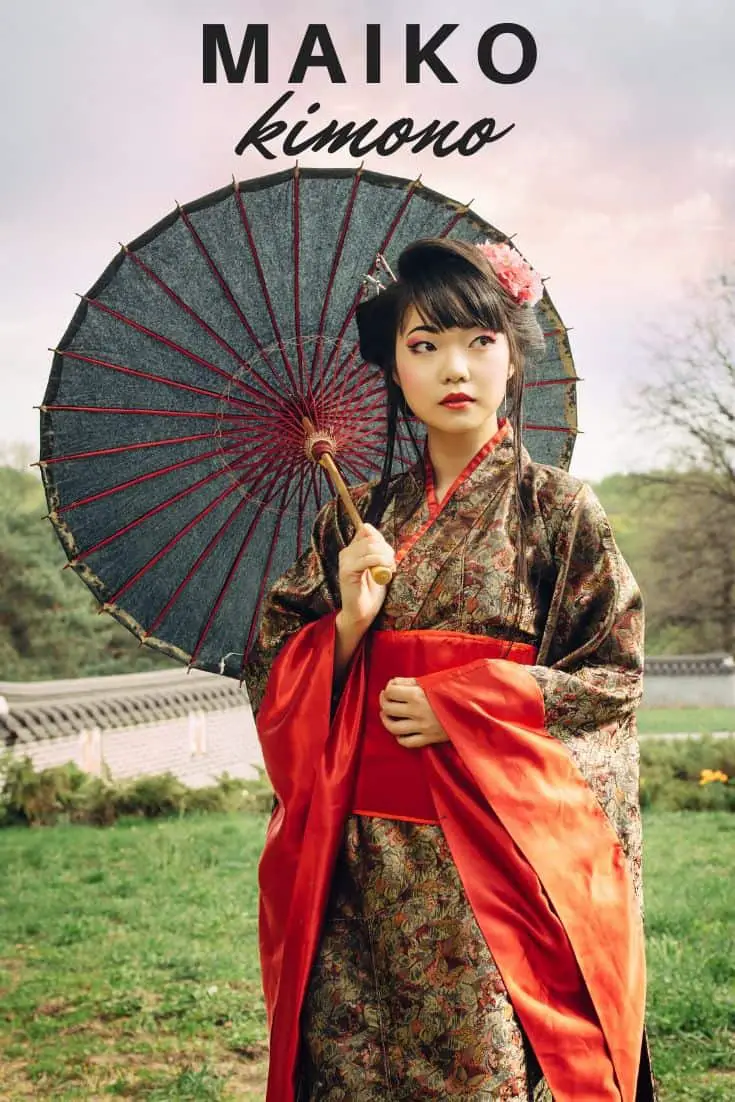
To be a Maiko, a Minarai should get herself a one-san, a senior geisha to learn form.
One-san means sister. As a Minarai entering her process as Maiko, a ceremony called Misedashi will be held.
The ceremony is to bind the Maiko and her One-san as sisters for life.
The relationship between a Maiko and her one-san is vital because a Maiko has to intensely shadow her one-san.
The one-san would take full responsibility in training and giving examples to her Maiko.
The word “Maiko” also means “half jewel”, representing the fact that a Maiko can be hired with half the price of a fully-trained Geisha.
Getting hired will give a Maiko a chance to get to know some of her potential clients later as a Geisha.
Geisha
Geisha is a fully-grown woman who is ready for her full-time career. One needs to be at least 21 years old to be able to debut as a Geisha.
By being a Geisha, she can charge full price. She will stay living in an Okiya until she retires.
If she has enough resources and ability, she can even build her own Okiya. A senior Geisha can recruit Maiko or at least be a One-san to a Maiko.
Hiki-Iwai
When a Geisha chooses to retire, she may get some kind of graduation ceremony called Hiki-Iwai. Most Geisha retire due to getting too old for public performance.
But sometimes, they choose to do so because they want to get married or simply have had enough with the lifestyle of a Geisha.
The training of a Geisha is somewhat military. A high level of discipline is essential because the training aims for perfection. The way Geisha act is taught detailedly.
It is clear to see now why training a Geisha would be a lot more effective if the process starts at a very young age.
From Maiko to Geisha
Moving forward from being a Maiko to being a full-fledged Geisha is similar to graduation because it marks the finish of her training.
The transformation also means that a girl is now entering adulthood as a woman. To mark such an important milestone, there are processes called Mizuage and Erikae.
Mizuage
Mizuage is a ritual of deflowering or losing virginity. Every time a Maiko has finished her training, the Okiya will hold an auction for its loyal guests.
Any man with the highest bid wins the right to deflower the particular Maiko and be her Danna (patron).
The money paid by Danna will be given to the Okiya as a “debt repayment” of all the expenses the Okiya had to spend to train the particular Maiko.
However, after the Mizuage night, a Geisha no longer has to have sex with her Danna or any of her customers.
Traditionally, Mizuage is a mandatory process that every Maiko has to go through so she can proceed to be a Geisha.
But in 1959, the government of Japan has made this practice illegal, because the concept is similar to prostitution.
Nowadays, Mizuage is just a process of accepting sponsorship by a Danna without the obligation of sexual service.
Many Maiko even proceed to be Geisha without a Mizuage ritual.
Erikae
Unlike Mizuage, Erikae is still practiced by every Maiko because this step is more important, and does not involve sexual matters.
Erikae is a formal ceremony that marks a Maiko to be a Geisha. At this moment, a Maiko will also receive a stage name to use as a Geisha.
The ceremony mainly involves changing the hairstyle and outfit, because Maiko dress differently to Geisha.
Erikae usually takes place a few months after Mizuage. After her Erikae, a Geisha can now receive full payment when a customer hires her.
The Skills of A Geisha
The training of a Geisha is highly demanding and meticulous. A girl should have discipline, dedication, and even wit.
Without any of those, it would be impossible to pass the training. Almost every little aspect is taught, including:
Makeup, Hairdo, and Dress Up
This one goes without saying. Geisha and even Maiko in training have a specific appearance. Their style is not easy to put on.
Conversation with Men
A fun conversation is the first way to charm men.
Geisha/Maiko must learn about the man’s ego and how to make them feel comfortable through light conversation over drinks.
Walk
A wooden pair of footwear is not easy to walk in. On the other hand, a Geisha should be gracious all the time.
Learning how to walk is one of the essential training that does not come easy.
Sleep
Forget about your fluffy cotton pillow. Such a thing will ruin the neat hairdo of a geisha.
Once debuting as a Maiko, she will have to learn how to sleep using a Takamura, a small cylindrical pillow to place right below your neck.
Using such neck support allows a Maiko/Geisha to relax their head without messing up her hairdo.
However, many Geisha nowadays wear wigs for sophisticated hair appearance. Hence, they can sleep normally using a pillow by simply removing their wigs.
Laugh
It is not elegant for a Japanese woman to laugh with her mouth exposed. Hence, Geisha should cover her mouth while laughing.
They can use a traditional hand fan or simply use their hand for such a purpose.
Geisha Games
A Geisha should also know a few Geisha games to play with their guests during dinner. The games are meant to loosen up the mood.
Geisha games are usually fun to play, especially because the guests should drink a shot if they lose as a punishment.
Art Performance
The geisha dinner usually includes an art performance, either it is a small one-person show or a big stage one.
During the training, maiko has to learn multiple Japanese art performances such as singing, dancing, and playing instruments.
But later when they grow up to be Geisha, many of them usually develop a specialization.
Japanese Culture
Being knowledgeable about Japanese culture is essential because many guests love talking about it during the conversation.
How much are geisha paid?
Nobody knows for sure how much Geisha and Maiko can earn per month.
It is estimated that a good Geisha can take about $3,000 to $10,000 per month, depending on the skill and experience.
However, they also have to spend a large sum of it to buy kimono and hair ornaments, which are known to be highly expensive.
It is known that Maiko mostly will not get any salary at the beginning of their debut. Training a Maiko is expensive.
An Okiya invests approximately $500,000 to train and prepare a Maiko. That amount includes fancy kimonos and lavish hair ornaments.
Hence, the money that Maiko earns usually goes to the Okiya as a payback.
Customers have to pay for the Maiko they hire. The tariff is usually around half of the Geisha’s tariff.
But the money will go to the Okiya until all the training expenses are paid back.
Most Maiko will not receive any of her income until at least three or four years after debuting as Maiko.
The Okiya
Okiya is the house where all the Geisha live since the first time they got recruited. Okiya is run by a senior or retired Geisha, called Oka-san (mother) or Okami-san.
The lodging house can take multiple Maiko and Geisha at the same time, while it can also have none living in it.
In ancient times, girls were either sold to or recruited by the Okiya as young as 5 or 6 years old. People believed that a lifetime of training will get you closer to perfection.
But according to the law, the girls need to be at least 15 years old to be able to get recruited in an Okiya. Even an Okiya needs a formal license to operate legally.
The relationship of all the Geisha in an Okiya is similar to an adopted family.
The Okami-san will be the Mother. The senior Geisha will be the One-san (sisters) for the Maiko and junior Geisha.
When the Okami-san passes away, the senior Geisha who lives in the Okiya can take her place as the new Okami-san.
The Okiya has everything needed to sustain the Geisha training and activities, including outfits, makeup, and art properties.
The Okiya is also responsible for paying all the expenses of all the people living in it, including the Maiko training.
It is also the Okiya who gets to arrange which Ochaya the Maiko and Geisha will work for.
While this place can be very welcoming for girls, boys are strictly forbidden to live in it. A Geisha who got married has to leave her Okiya so she can live with her husband.
Even if a single Geisha gets pregnant and later gives birth to a son, she has to choose between giving her son away to get adopted by another family or leave her Okiya so she can raise her son on her own.
The Ochaya
The word Ochaya means “tea house”. It is the traditional establishment for all the entertainment services by Geisha.
The place offers tea, alcoholic beverages, art performance, and escort services by the Geisha. Similar to Okiya, Ochaya also requires a license for legal operation.
An Ochaya does not run with the same system as common bars or restaurants. They will not bill their guest for each visit.
Instead, they will recap all the expenses spent by the guests and send the accumulative bill monthly. This system is the reason why a circle of trust is vital amongst the guests.
Traditionally, not everybody has the right to access an Ochaya. The place is exclusive for invitations only.
Existing customers of an Ochaya can refer their friends to get invited to the Ochaya. But if a guest causes trouble, his referral would be held accountable by the Ochaya.
Hence, guests will not refer random friends to the Ochaya because this may affect his reputation.
Also, you need a very wealthy man with a good reputation and social status to get someone willing to refer you to an Ochaya.
However, as the business gets more difficult to survive, Ochaya becomes less restrictive with time.
In this era, some travel agencies can send tourists to an Ochaya if they pay at least a specific amount of money requested by the Ochaya.
There are also interpreter services for Ochaya guests who do not speak Japanese.
Geiko or Maiko Dinner
Ochaya has enclosed tatami rooms where you can experience a full traditional dinner with Maiko or Geiko.
Customers are free to order how many Geiko and Maiko to be in their chambers.
Customers don’t have to be alone for this dinner. Many times, men like to have a group dinner with their buddies to have fun together.
The dinner will start with light conversation and drinking. The choices of beverages are varied, from traditional to modern, both alcoholic and non-alcoholic.
The Geiko or Maiko will pour drinks to your cup each time it gets empty. They may also drink along if you say so.
Geiko and Maiko received training to be interesting conversationalists. They even learned about men’s egos to know how to charm them through communication.
Moreover, Maiko and Geiko also get themselves updated with the topics trending amongst men so they can stay relevant along the way.
The foods are usually served in a sophisticated presentation with meticulous detail to make a high-class experience of your dining.
Of course, the menu would be all authentic Japanese food, which mainly is seafood.
Of course, there will also be some art performances by the Geiko/Maiko. It could be some instrumental music play, singing, or dance.
During the performance, guests are expected to behave respectfully.
To make the most fun of the experience, Maiko/Geiko will also take the customers to play some traditional Geiko games.
The winning customer may receive small prizes. But if he loses, he should take a shot of beer as a punishment.
It is the Geisha’s responsibility to make their customers feel comfortable to talk about anything they have in mind.
Geisha and Maiko have a strict code of keeping the secrets of their customers.
Everything they hear and see from their customers must not be shared or discussed even to fellow Geisha.
The Clothes and Makeup of A Geisha
Geisha are notable for their sleek and sophisticated appearance. Their clothes have strict rules and codes.
There are differences between the appearance of Geisha, Maiko, Oiran, and even the common Japanese women.
Here are how to tell Geisha and Maiko from their appearance:
Kimono
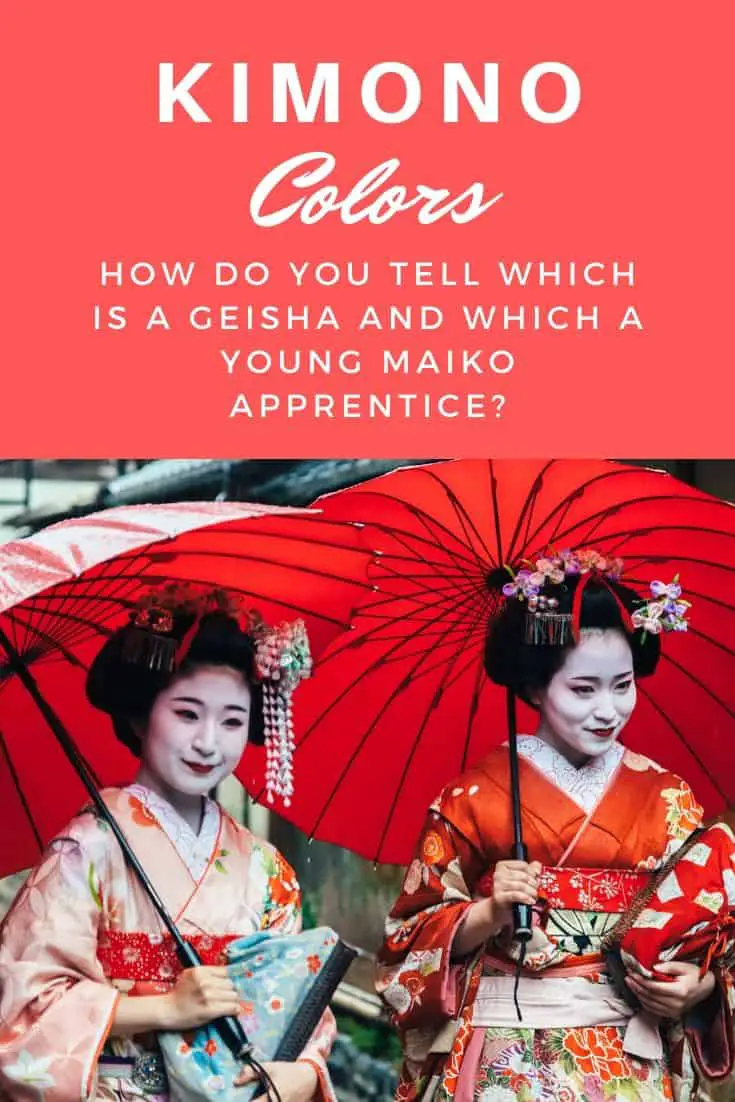
While commoners wear kimonos that cover their neckline, the ones that Geisha/Maiko wear are exposing the nape of the neck.
This exposure appears to be sensual in Japanese culture.
You can define a Maiko by the red color of their collars. Also, maiko’s kimonos are usually in bright colors with intricate embroidery.
They look cheerful and young as they are. The sleeves are padded and long, trailing the ground as the Maiko puts her arms down.
Geisha wear their collar in white color. Unlike Maiko, Geisha’s kimonos are mostly in a bold and single color.
The ornament is more minimalist and is usually just around the bottom part of the kimono. Overall, Geisha’s clothes have more allure. Even their sleeves are shorter.
Obi
Obi is the large cloth belt to keep the kimono neat in its place. Geisha usually wear Obi that are brighter than their kimono to pop the color out.
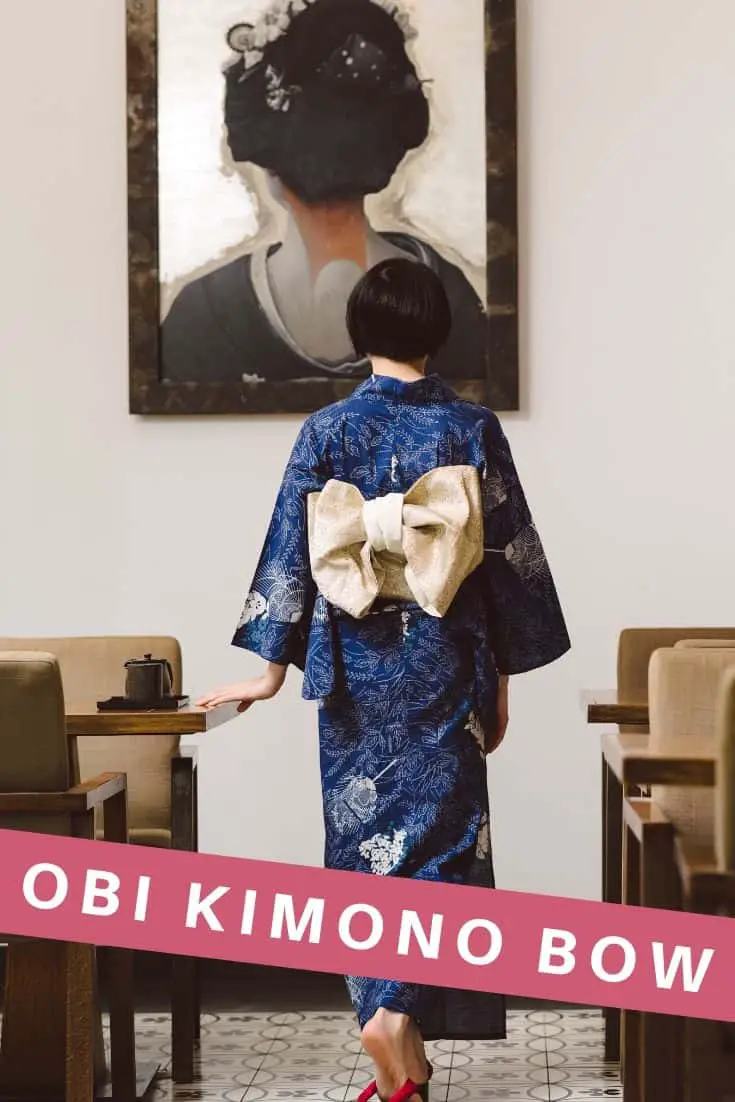
Maiko’s obi are usually larger and more extravagant, while Geisha’s ones are narrower and simpler.
Both Geisha and Maiko knot their obi at the back, while an Oiran knot it at the front for easier access.
Maiko’s knot is more complex. They need another person’s help to do it for them.
Footwear
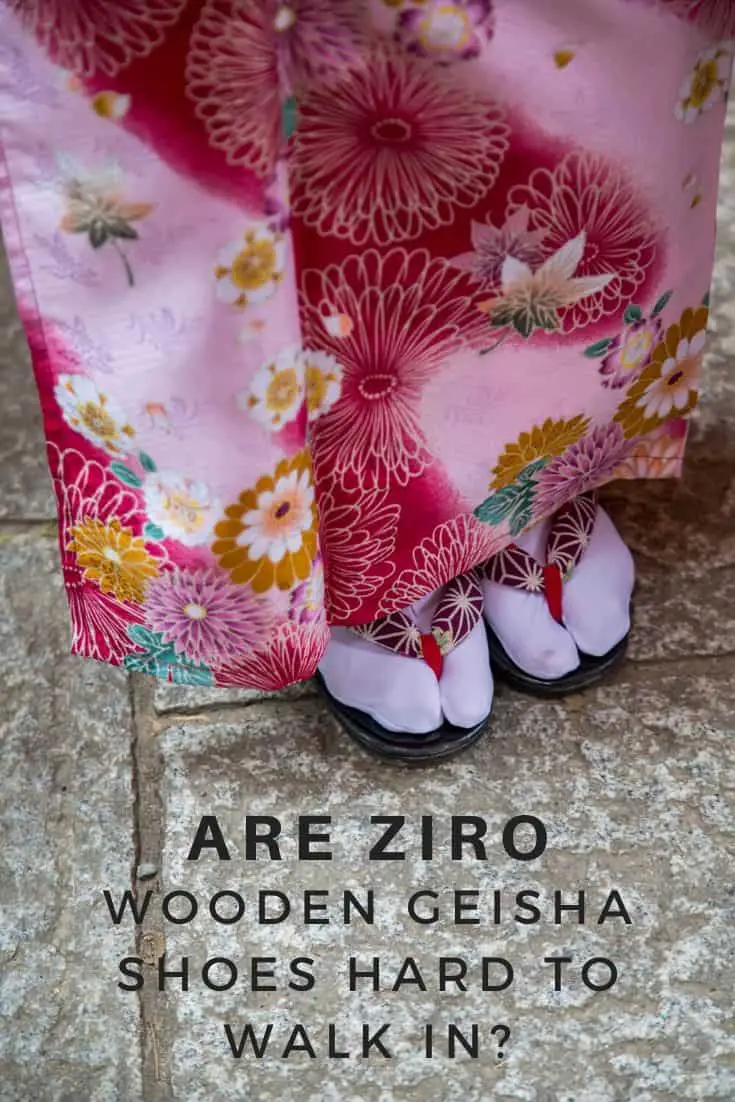
The most unique part of a Maiko’s appearance is her footwear. A high platform of wooden sandals called Okobo is not something easy to walk in.
Meanwhile, Geisha walk a lot more easily, because they only wear flat sandals called Ziro. Both Geiko and Maiko also wear a kind of buttoned socks called Tabi.

Hairstyle
Both Geisha and Maiko have elaborate hairstyles decorated with kanzashi (a hairpin).
Maiko still must wear their natural hair, but Geisha have the option to wear wigs to make it easier and healthier for their hair.
Geisha’s simple bun is prominent with the name “Shimada”. Meanwhile, Maiko has five different buns for each of the training steps.
They are
- wareshinobu
- ofuku
- momoware
- katsuyama
- and sakko
Nagajuban
Nagajuban is a thin robe used as an undergarment.
When wearing a kimono, most Geisha and Maiko would not wear modern underwear as those might disrupt their kimono lines.
Maiko usually wear red colors, while Geiko can wear any other color.
Although formal kimonos can go up to 12 to 20 layers, Geisha and Maiko do not wear that much. There are only a few layers as mentioned above.
However, on a more formal occasion, their kimono and hairstyle would be much more extravagant.
The Make-Up
Geisha and Maiko are easily recognizable for their ivory-white paint on their face called oshiroi and the bright red lipstick.
Some senior geisha stop wearing oshiroi as they get older. On the other side of the cycle, Maiko usually have thicker oshiroi at the beginning of their training.
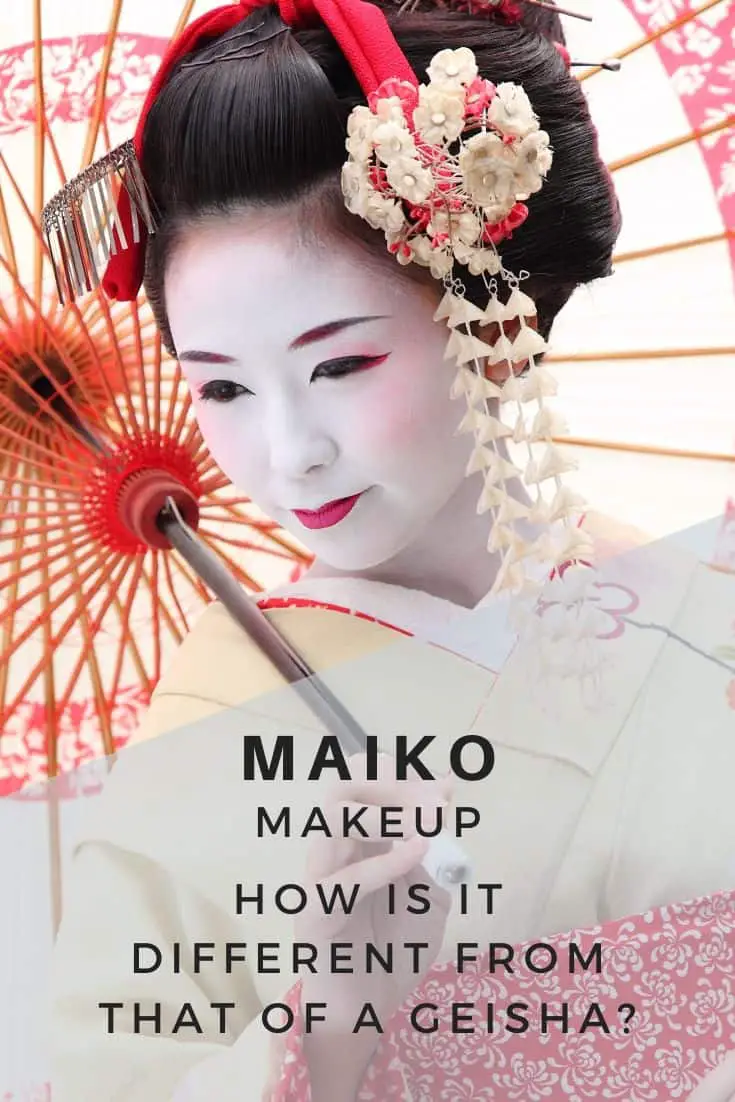
The make-up starts with a layer of wax or oil called bintsuke-abura to apply as a base. Next, oshiroi can be applied all over the face, neck, to the nape of the neck.
The paste is a mixture of white rice powder and water.
After applying oshiroi, Geisha and Maiko will finish their make-up with red lipstick, neat eyebrows, and sharp eyeliner.
The reason behind the extreme color is because white is considered a color of perfection.
Furthermore, oshiroi can cover any imperfection on the face such as pimples and fine lines.
The makeup gets less important for senior geisha as they already have enough charms such as conversational wit and artistic skills.
Have A Geisha Kimono of Your Own
Kimonos are not cheap clothes to buy, especially the ones worn by Maiko and Geisha. The prices vary, depending on the fabric used and how elaborate the embroidery is.
For Geisha and Maiko, their best option is ones made of organic silk. With complex embroidery, one set of kimono can cost more than $10,000.
However, kimonos with regular silk cost only around $240 to $800. For a cheaper option, they can go with faux silk material.
A brand called Sillook offers a set of kimono in faux silk with only around $150 or a little bit more.
In the winter, wool kimonos may provide more warmth and comfort. The price is starting at $240.
But if you only look for regular kimonos like what common women wear, they cost only about $40 each for the one made of cotton.
Rather than buying, you might want to consider a rental if you only need to wear the kimono once.
In Japan, especially in Tokyo and Kyoto, you may find many kimono rental companies.
For a fancy silk kimono that Geisha and Maiko wear, the rental fee is around $34 to $50.
You can even ask for a make-up and photoshoot service from the company with a little bit of additional fee.
The Off-Hours
The personal life of a geisha is very different today as it was in ancient times.
In general, geisha today have more freedom and ease to have a happy personal life, while the ancient geisha had to face a few rules and consequences to live life as they want it.
The contracts between Geisha/Maiko and their Okiya (nenki) are much simpler and easier nowadays.
Hence, they are free to do as they wish in their free time, including wearing modern clothes and hanging out in the mall.
Nowadays, Maiko have two days off each month. Geisha are free to arrange their working schedule. Even a Maiko in training can still attend high school.
Geisha and Maiko have the option to quit anytime. Many Maiko did not even make it to their debut as full-fledged Geisha.
Furthermore, most Geisha choose to retire around the age of thirty to forty, mainly because they want to get married and start a family.
Sex, Love, and Family
Sex is not a part of the Geisha’s job description, especially since the Anti-Prostitution Law in 1959.
Sometimes, a Geisha would agree to sleep with her client or anyone she wants. It is all her personal decision.
Bear in mind that it would be highly disrespectful to demand sex activities with the Geisha/Maiko you hire during dinner.
Falling in love is common for Geisha, both in the ancient and modern days. However, having a relationship is another thing.
Formerly, a geisha had to retire from her profession and pay off her nenki first if she wanted to get married.
Getting pregnant outside marriage was also an issue in the olden days.
Since boys are not allowed to live in an Okiya, a Geisha should choose between giving him up for adoption or to leave her Okiya for good to raise him on her own.
If the baby turned out to be a girl, she might have to be a Geisha as well in the future if her mother raises her in the Okiya.
With so much restriction, most Geisha in ancient times chose to stay single for the rest of their lives.
Some managed to fall in love and get married, especially those who were in a romantic relationship with their patron.
Logically speaking, it must be easy for a patron to pay off his girlfriend’s contract with all the wealth he possesses.
Meanwhile, in the modern days, married women, even those who have children, may continue working as Geisha without having to endure significant consequences.
It is pretty common now to see Geisha and Maiko have romantic relationships with anyone they love.
Since nenki is much simpler, a Geisha doesn’t need an extremely wealthy man to pay it off.
How to Meet A Geisha
The amount of Geisha has been drastically declining in the last few decades.
How many geisha are there in Kyoto?
The exact number is unknown. Estimated, there are about two hundred Geisha in Kyoto. In Japan, there are about four hundred of them. There used to be about 80,000 of them in 1920, but now there are only less than 1,000 Geisha in total.
If you are traveling to Japan and wish to see them, there are many options you can consider. Here they are:
At the Hanamichi
Hanamichi is the neighborhood of geisha. Within the area, most likely you will find Okiya, Ochaya, Ryutei (restaurant), places where Maiko take their art training, and some other things required for a Geisha business.
There are six hanamichi in Tokyo and five in Kyoto.
For a better chance of encountering Geisha and Maiko walking on their way to work, try staying around the neighborhood around 5:30 to 6:00 in the evening.
Although this trick is the cheapest way to meet Geisha/Maiko, you will have not much chance of interacting with them.
You might not even be lucky enough to get a proper photograph with them.
At the Festival
Japan has many cultural festivals where many Geisha/Maiko also attend. Here are some festivals and celebrations where you can take a chance:
- Asakusa Toshi no Ichi Fair
- Kagurazaka Street Stage Oedo Tour
- Yasaka Shrine Setsubun
- Higashiyama Hanatouro Festival
- Kyoto Gion Festival
A festival can be crowded and busy.
Even if you are lucky enough to spot Geisha or Maiko, there are chances that the condition is impossible for you to get a good photo or have a nice conversation with them.
During A Performance
Odori is a traditional dance performance. The tickets are highly affordable, starting from $15 up to $50 per person.
This is the best way to see geisha and maiko while also watching their well-trained talent.
Japan has many Odori schedules in many places, so you can easily find one that matches your visiting dates.
Even so, it is best to check the schedule and book your ticket ahead of time to make sure you will not miss out.
Book A Geiko Dinner
A geiko dinner is inarguably the best chance to meet a geisha. Because not only will you be able to take a picture, but you can have a fun and long conversation with them.
The Geisha and Maiko you hire will perform their dance privately for your or your group in the tatami room.
Although Ochayas are not as strict as they used to be in welcoming new customers, you still need a lot of money to make it happen.
Many tourism agencies offer a geiko dinner with a minimum tariff of $200 to $450 per session.
An additional fee might charge, especially if you order more food, drinks, or Geisha/Maiko to accompany your evening.
The Etiquette of Interacting with Geisha
Geisha are aware that they represent the unique culture of Japan.
They also understand that tourists will have an interest in them, either simply to take photos or have some interaction.
However, many Geisha complained about how many tourists treat them as cultural subjects, which is rude.
Geisha are highly respected in Japan. They are also human, like us. Here are some things you have to bear in mind if you plan to meet a geisha:
- If you want to take a picture of them, ask nicely. Do not snap your camera without their permission like a paparazzi. If they refuse, please respect their choice.
- Be considerate if you want to talk to them on the street. They might be in a hurry, so don’t force them to spare their time for you.
- If you need to talk or take a photo with Geisha on the street, do not block their way. It is better to stand on the side or the back.
- Do not ever ask a Geisha for sex. Geisha are not meant to serve their customers with sexual activities.
We can say that geisha is one of the faces of Japanese culture and hospitality.
Unfortunately, their numbers are declining rapidly. However, their charms will never fade.
Check out our new cookbook
Bitemybun's family recipes with complete meal planner and recipe guide.
Try it out for free with Kindle Unlimited:
Read for freeJoost Nusselder, the founder of Bite My Bun is a content marketer, dad and loves trying out new food with Japanese food at the heart of his passion, and together with his team he's been creating in-depth blog articles since 2016 to help loyal readers with recipes and cooking tips.
